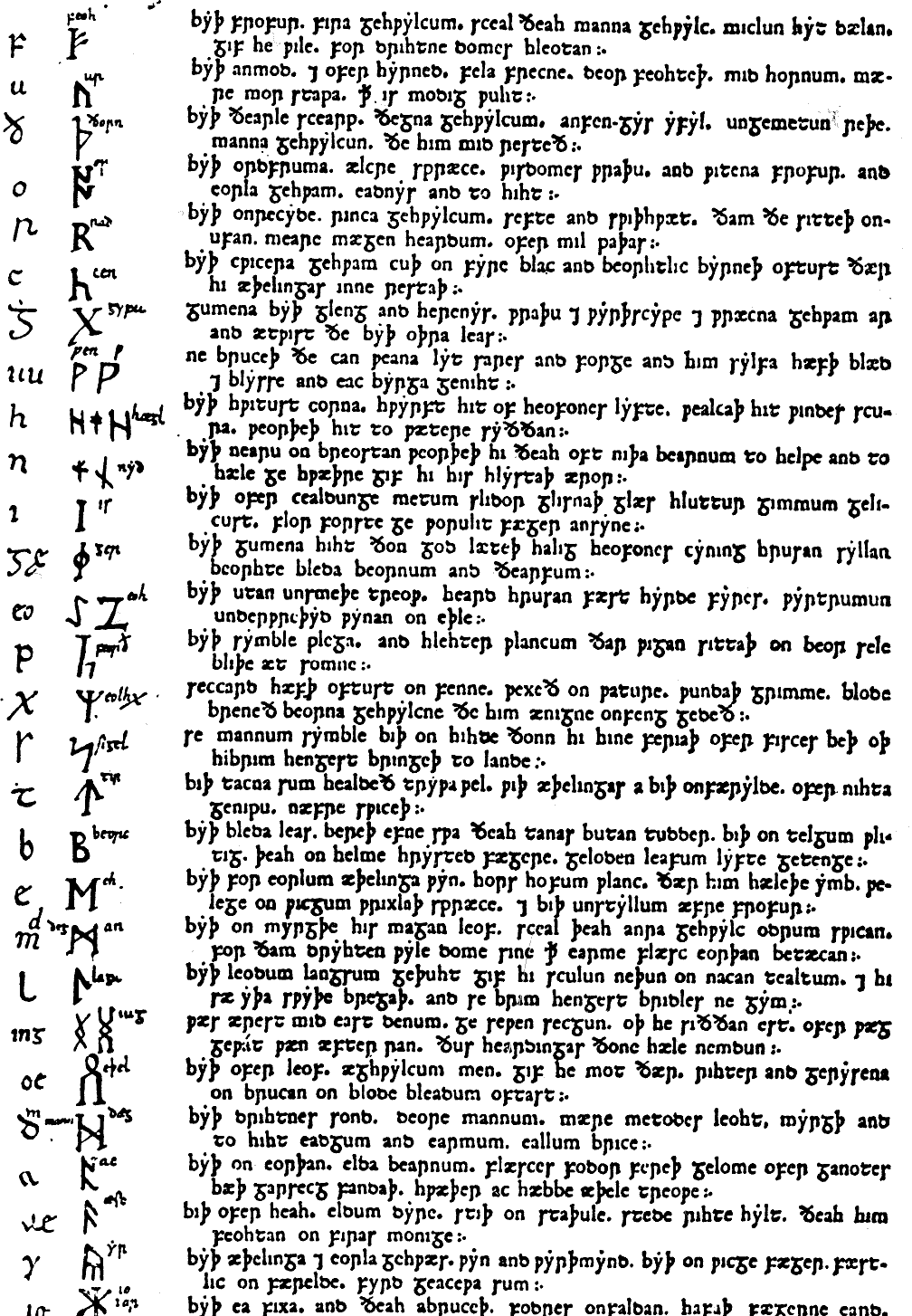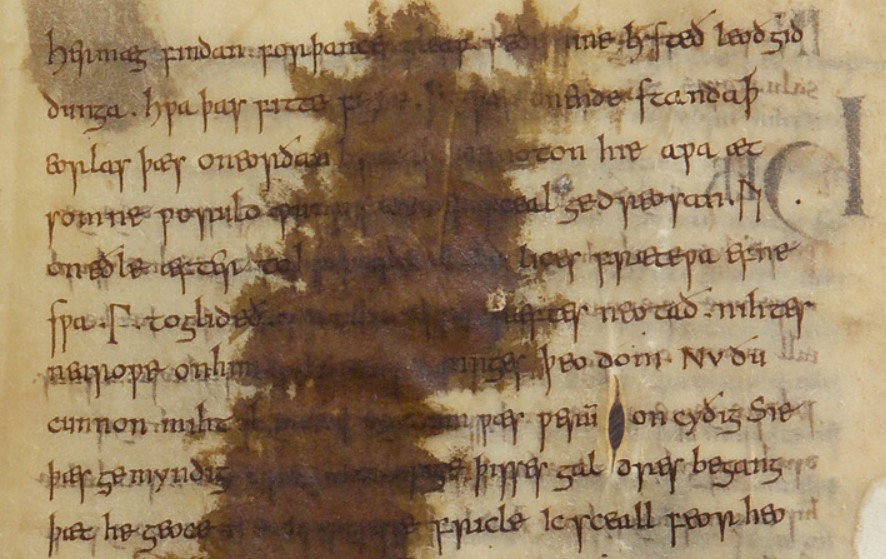|
Old English Rune Poem
The Old English rune poem, dated to the 8th or 9th century, has stanzas on 29 Anglo-Saxon runes. It stands alongside younger rune poems from Scandinavia, which record the names of the 16 Younger Futhark runes. The poem is a product of the period of declining vitality of the runic script in Anglo-Saxon England after the Christianization of the 7th century. A large body of scholarship has been devoted to the poem, mostly dedicated to its importance for runology but to a lesser extent also to the cultural lore embodied in its stanzas. The sole manuscript recording the poem, Cotton Otho B.x, was destroyed in the Cotton Fire of 1731, and all editions of the poems are based on a facsimile published by George Hickes in 1705. History of preservation The poem as recorded was likely composed in the 8th or 9th century.Van Kirk Dobbie (1965:XLIX). It was preserved in the 10th-century manuscript Cotton Otho B.x, fol. 165a – 165b, housed at the Cotton library in London. The first mention ... [...More Info...] [...Related Items...] OR: [Wikipedia] [Google] [Baidu] |
Rune Poem Hickes 1705
Runes are the letters in a set of related alphabets known as runic alphabets native to the Germanic peoples. Runes were used to write various Germanic languages (with some exceptions) before they adopted the Latin alphabet, and for specialised purposes thereafter. In addition to representing a sound value (a phoneme), runes can be used to represent the concepts after which they are named (ideographs). Scholars refer to instances of the latter as ('concept runes'). The Scandinavian variants are also known as ''futhark'' or ''fuþark'' (derived from their first six letters of the script: '' F'', '' U'', '' Þ'', '' A'', '' R'', and '' K''); the Anglo-Saxon variant is ''futhorc'' or ' (due to sound-changes undergone in Old English by the names of those six letters). Runology is the academic study of the runic alphabets, runic inscriptions, runestones, and their history. Runology forms a specialised branch of Germanic philology. The earliest secure runic inscriptions date from a ... [...More Info...] [...Related Items...] OR: [Wikipedia] [Google] [Baidu] |
Algiz
Algiz (also Elhaz) is the name conventionally given to the "''z''-rune" of the Elder Futhark runic alphabet. Its transliteration is ''z'', understood as a phoneme of the Proto-Germanic language, the terminal ''*z'' continuing Proto-Indo-European terminal ''*s''. It is one of two runes which express a phoneme that does not occur word-initially, and thus could not be named acrophonically, the other being the ''ŋ''-rune Ingwaz . As the terminal ''*-z'' phoneme marks the nominative singular suffix of masculine nouns, the rune occurs comparatively frequently in early epigraphy. Because this specific phoneme was lost at an early time, the Elder Futhark rune underwent changes in the medieval runic alphabets. In the Anglo-Saxon futhorc it retained its shape, but it was given the sound value of Latin ''x''. This is a secondary development, possibly due to runic manuscript tradition, and there is no known instance of the rune being used in an Old English inscription. In Proto-Nor ... [...More Info...] [...Related Items...] OR: [Wikipedia] [Google] [Baidu] |
List Of Runestones
There are about 3,000 runestones in Scandinavia (out of a total of about 6,000 runic inscriptions). p. 38. The runestones are unevenly distributed in Scandinavia: The majority is found in Sweden, estimated at between 1,700 and 2,500 (depending on definition). Denmark has 250 runestones, and Norway has 50. There are also runestones in other areas reached by the Viking expansion, especially in the British Isles ( Manx runestones, Page, Raymond I. (1995). Runes and Runic Inscriptions: Collected Essays on Anglo-Saxon and Viking Runes'. Parsons, D. (ed.) Woodbridge: Boydell Press, 207–244 England runestones, Scotland and Ireland) and other islands of the North Atlantic (Faroes, Greenland, but not in Iceland), and scattered examples elsewhere (the Berezan' Runestone in Eastern Europe, Pritsak, O. (1987). ''The Origin of Rus'.'' Cambridge, Mass.: Distributed by Harvard University Press for the Harvard Ukrainian Research Institute. Sawyer, Birgit. (2000). The Viking-Age Rune-Stones ... [...More Info...] [...Related Items...] OR: [Wikipedia] [Google] [Baidu] |
Cynewulf
Cynewulf (, ; also spelled Cynwulf or Kynewulf) is one of twelve Old English poets known by name, and one of four whose work is known to survive today. He presumably flourished in the 9th century, with possible dates extending into the late 8th and early 10th centuries. Known for his religious compositions, Cynewulf is regarded as one of the pre-eminent figures of Anglo-Saxon Christian poetry. Posterity knows of his name by means of runic signatures that are interwoven into the four poems which comprise his scholastically recognized corpus. These poems are: '' The Fates of the Apostles'', ''Juliana'', ''Elene'', and ''Christ II'' (also referred to as ''The Ascension''). The four signed poems of Cynewulf are vast in that they collectively comprise several thousand lines of verse. In comparison, the one work attributed to Cædmon, ''Cædmon's Hymn'', is quite succinct at nine lines. Life Dialect Some basic statements can be made by examining such aspects as the spellings of hi ... [...More Info...] [...Related Items...] OR: [Wikipedia] [Google] [Baidu] |
Miller Wolf Oberman
Miller Wolf Oberman is a former Ruth Lilly Fellow as well as a 2016 winner of the 92nd St Y’s Boston Review/ Discovery Prize. His translation of selections from the “Old English Rune Poem” won Poetry’s John Frederick Nims Memorial Prize For Translation in 2013. Miller's first book "The Unstill Ones," a collection of poems and Old English translations was published in September 2017 by Princeton University Press. He lives in Brooklyn with his wife, rock singer Louisa Rachel Solomon of The Shondes, and holds a PhD in English from the University of Connecticut. Awards Discovery/Boston Review Prize, 2016. AWP Intro Award Journals Project, 2014 Honorable Mention for “Lies After the War.” John Frederick Nims Memorial Prize for Translation, 2013, awarded by Poetry Magazine for the “Old English Rune Poem.” The Wallace Stevens Student Poetry Prize, 2014. Finalist for the Montreal International Poetry Prize, 2012. Winner of a Dorothy Sargent Rosenberg Prize, 2009. ... [...More Info...] [...Related Items...] OR: [Wikipedia] [Google] [Baidu] |
Peorð
is the rune denoting the sound ''p'' (voiceless bilabial stop) in the Elder Futhark runic alphabet. It does not appear in the Younger Futhark. It is named peorð in the Old English rune poem, Anglo-Saxon rune-poem and glossed enigmatically as follows: : ''peorð byþ symble plega and hlehter / ƿlancum [on middum], ðar ƿigan sittaþ / on beorsele bliþe ætsomne'' :"Peorð is a source of recreation and amusement to the great, where warriors sit happily together in the beerhall." The name is not comprehensible from Old English language, Old English, i.e. no word similar to ''peorð'' is known in this language. According to a 9th-century manuscript of Alcuin (Codex Vindobonensis 795), written using the Gothic alphabet in Britain, the letters ''p'' (based on a Greek Pi (letter), Π) and ''q'' (an inverted Π) are called "pairþra" and "qairþra", respectively. One of these names clearly is derived from the other. However, the names are not comprehensible in Gothic either, an ... [...More Info...] [...Related Items...] OR: [Wikipedia] [Google] [Baidu] |
Elder Futhark
The Elder Futhark (or Fuþark), also known as the Older Futhark, Old Futhark, or Germanic Futhark, is the oldest form of the runic alphabets. It was a writing system used by Germanic peoples for Northwest Germanic dialects in the Migration Period. Inscriptions are found on artifacts including jewelry, amulets, plateware, tools, and weapons, as well as runestones in Scandinavia, from the 2nd to the 10th centuries. In Scandinavia, beginning in the late 8th century, the script was simplified to the Younger Futhark, while the Anglo-Saxons and Frisians instead extended it, giving rise to the Anglo-Saxon futhorc. Both the Anglo-Saxon futhorc and the Younger Futhark remained in use during the Early and the High Middle Ages respectively, but knowledge of how to read the Elder Futhark was forgotten until 1865, when it was deciphered by Norwegian scholar Sophus Bugge. Description The Elder Futhark (named after the initial phoneme of the first six rune names: F, U, Þ, A, R and K) has ... [...More Info...] [...Related Items...] OR: [Wikipedia] [Google] [Baidu] |
Mars
Mars is the fourth planet from the Sun and the second-smallest planet in the Solar System, only being larger than Mercury. In the English language, Mars is named for the Roman god of war. Mars is a terrestrial planet with a thin atmosphere (less than 1% that of Earth's), and has a crust primarily composed of elements similar to Earth's crust, as well as a core made of iron and nickel. Mars has surface features such as impact craters, valleys, dunes and polar ice caps. It has two small and irregularly shaped moons, Phobos and Deimos. Some of the most notable surface features on Mars include Olympus Mons, the largest volcano and highest known mountain in the Solar System and Valles Marineris, one of the largest canyons in the Solar System. The Borealis basin in the Northern Hemisphere covers approximately 40% of the planet and may be a large impact feature. Days and seasons on Mars are comparable to those of Earth, as the planets have a similar rotation period ... [...More Info...] [...Related Items...] OR: [Wikipedia] [Google] [Baidu] |
Woden
Odin (; from non, Óðinn, ) is a widely revered god in Germanic paganism. Norse mythology, the source of most surviving information about him, associates him with wisdom, healing, death, royalty, the gallows, knowledge, war, battle, victory, sorcery, poetry, frenzy, and the runic alphabet, and depicts him as the husband of the goddess Frigg. In wider Germanic mythology and paganism, the god was also known in Old English as ', in Old Saxon as , in Old Dutch as ''Wuodan'', in Old Frisian as ''Wêda'', and in Old High German as , all ultimately stemming from the Proto-Germanic theonym *''Wōðanaz'', meaning 'lord of frenzy', or 'leader of the possessed'. Odin appears as a prominent god throughout the recorded history of Northern Europe, from the Roman occupation of regions of Germania (from BCE) through movement of peoples during the Migration Period (4th to 6th centuries CE) and the Viking Age (8th to 11th centuries CE). In the modern period, the rural folklore of Germani ... [...More Info...] [...Related Items...] OR: [Wikipedia] [Google] [Baidu] |




